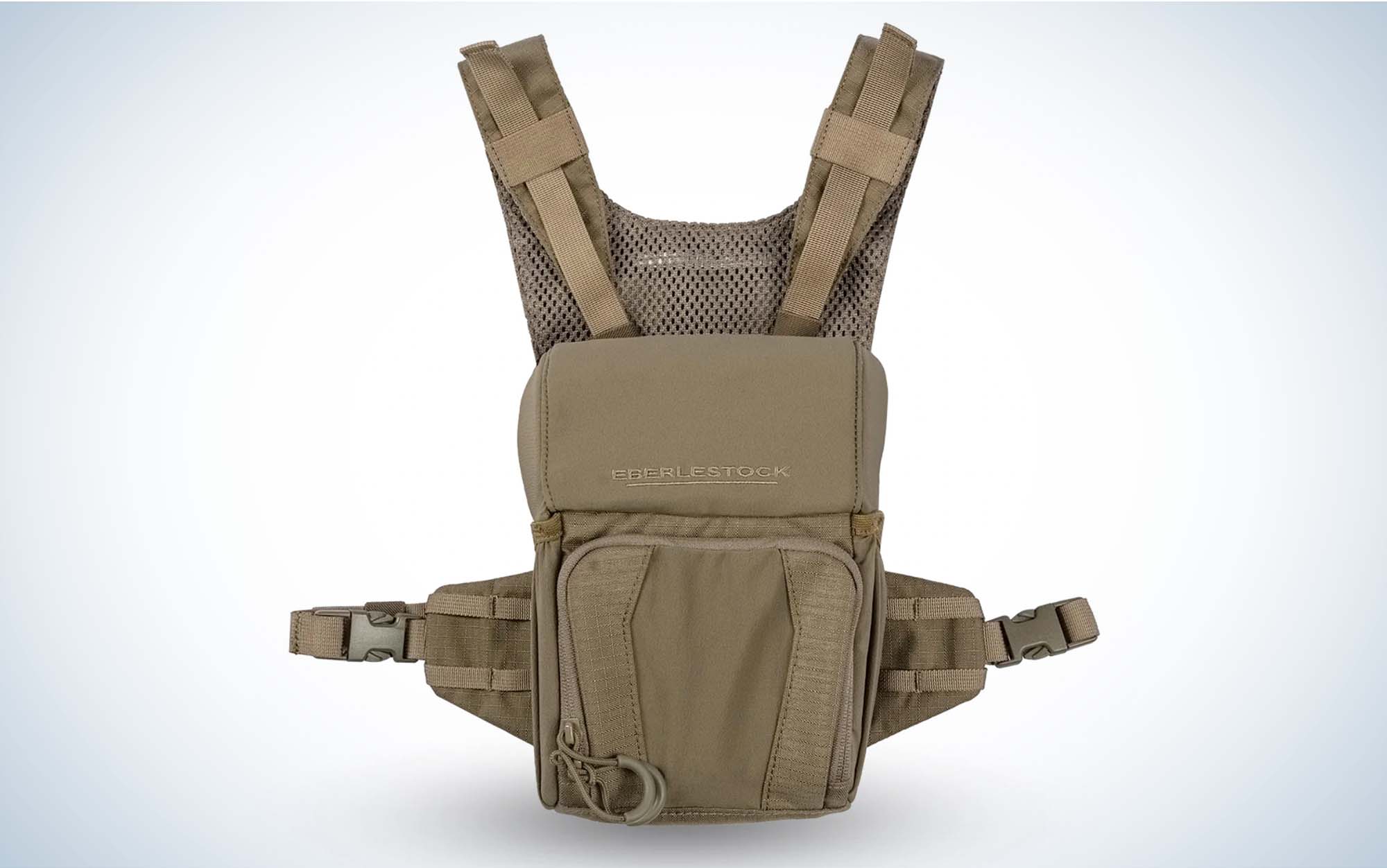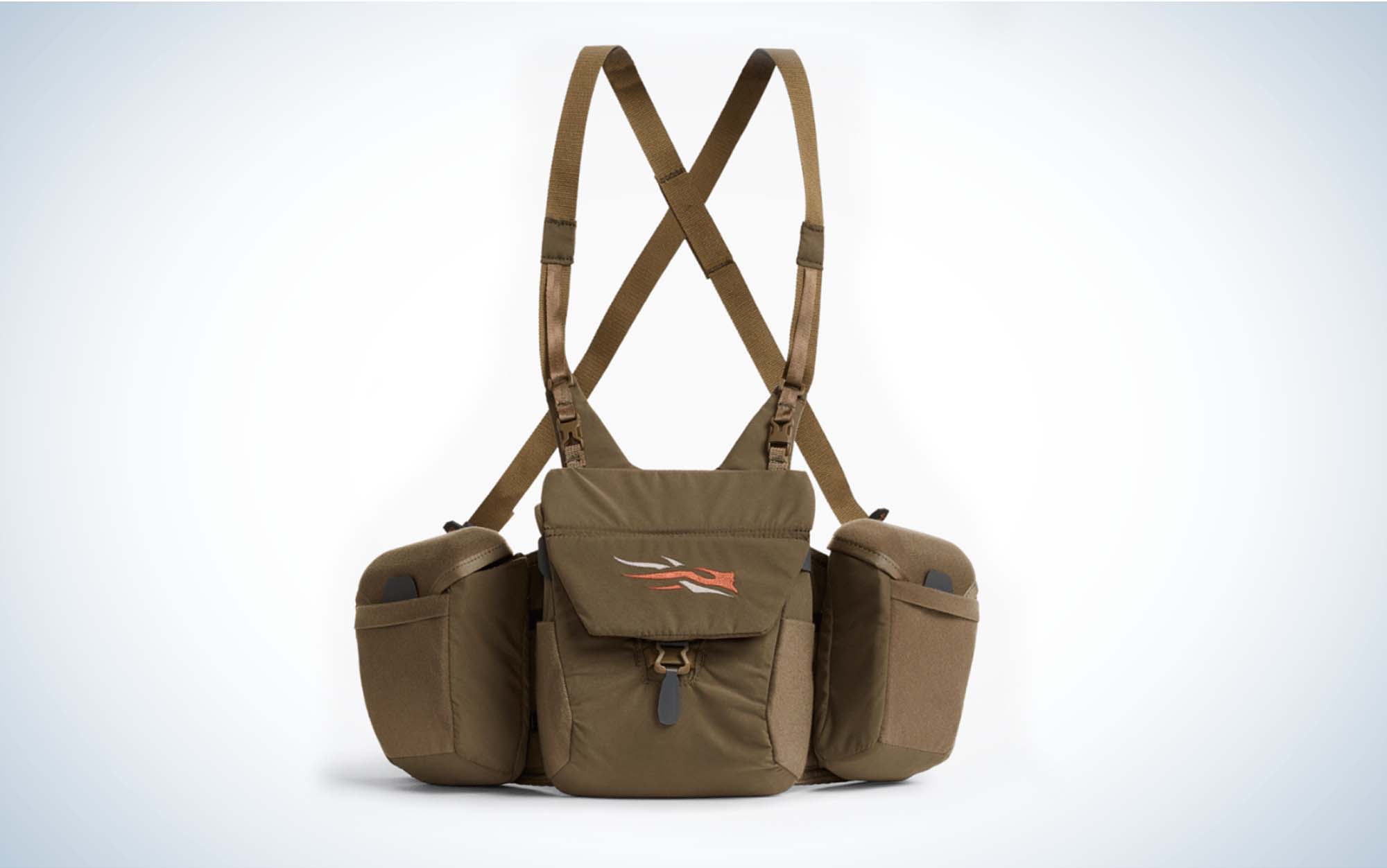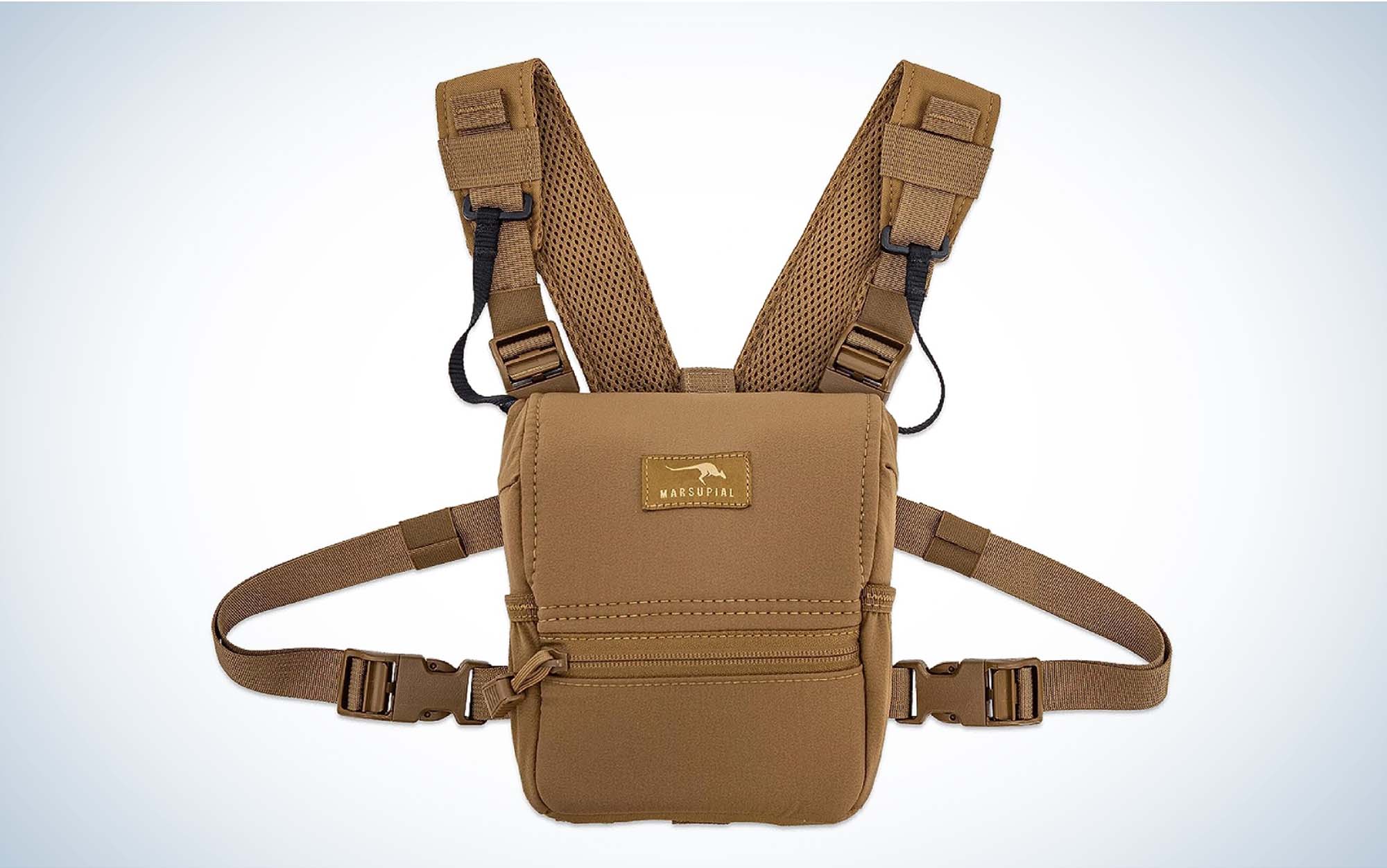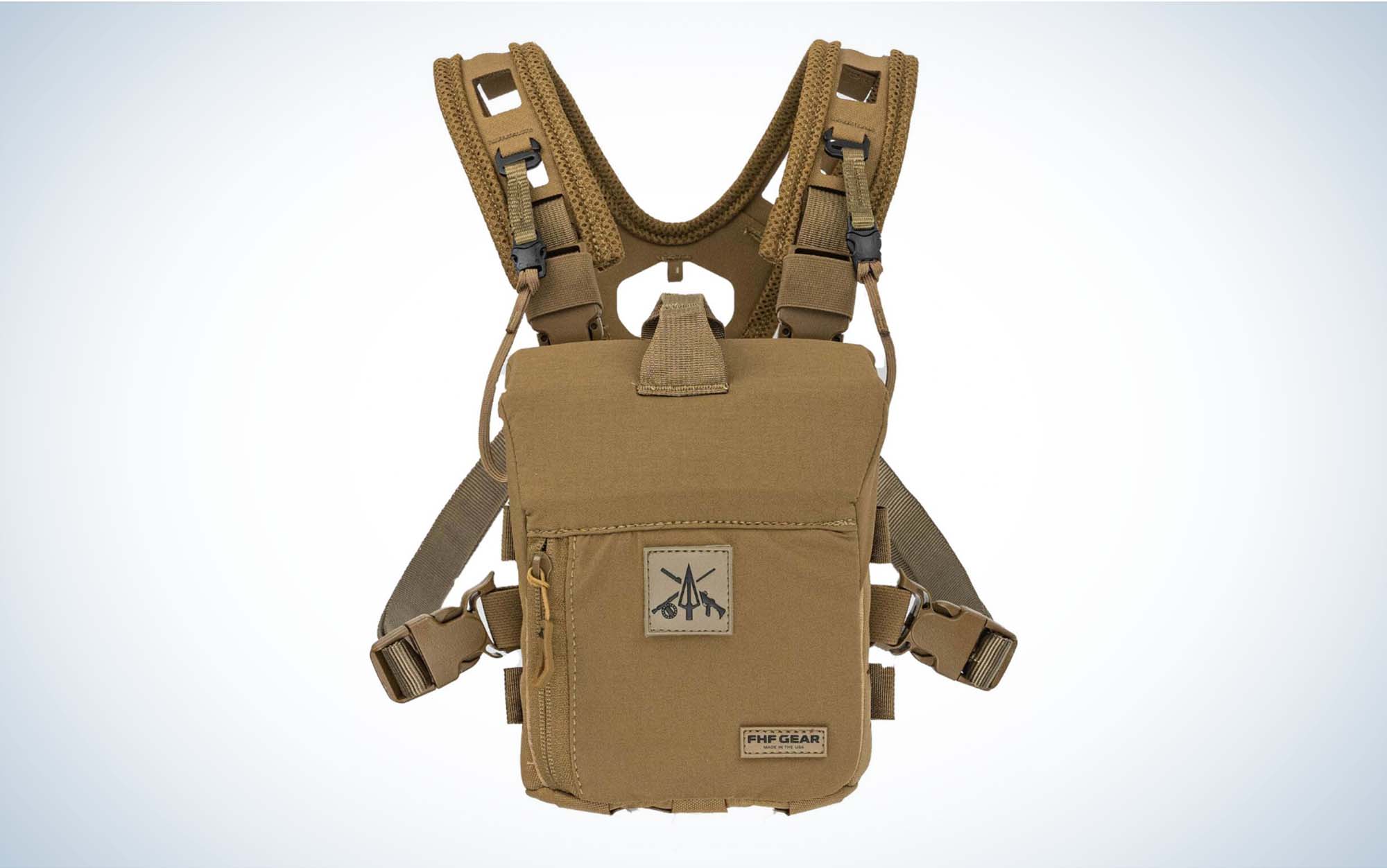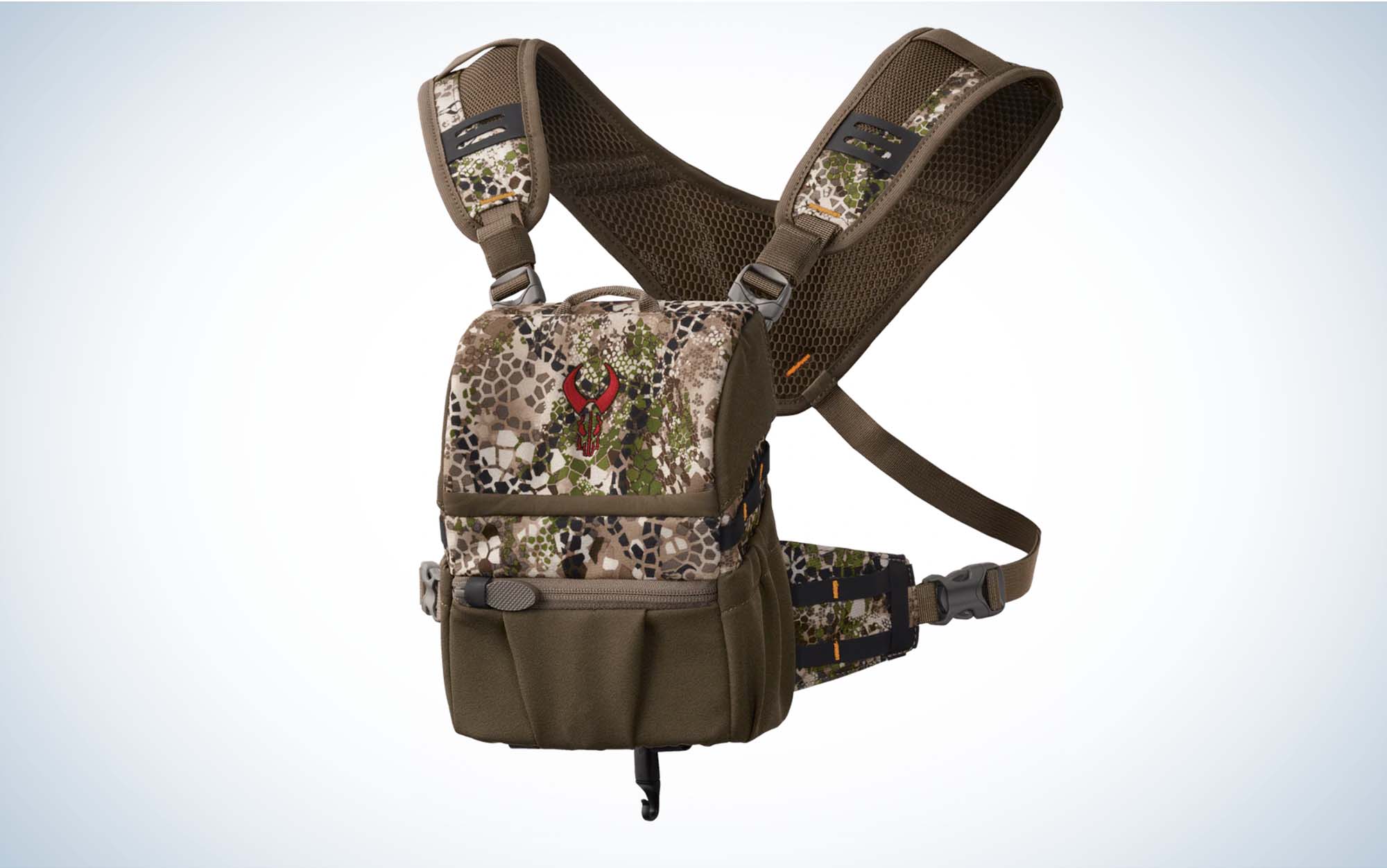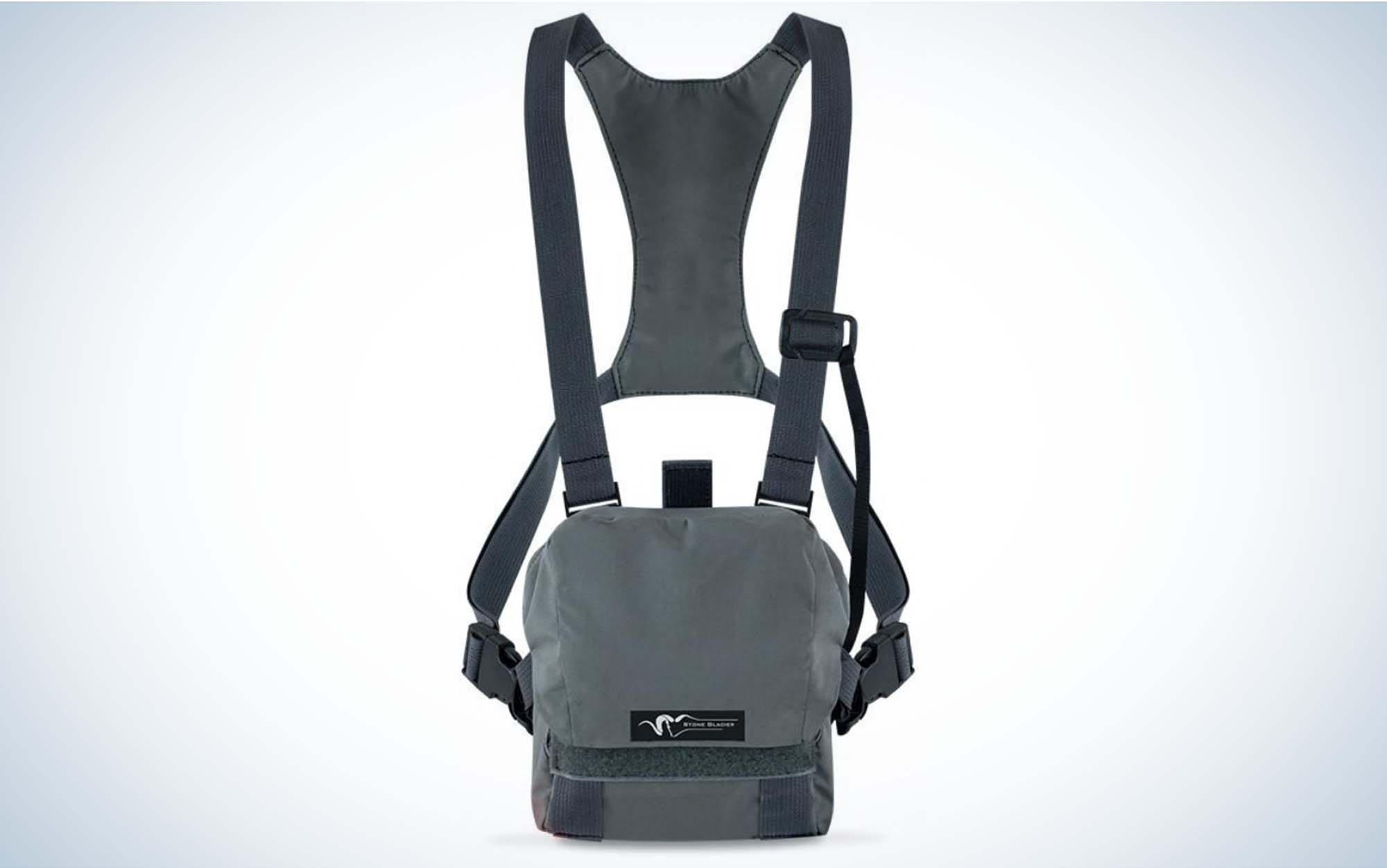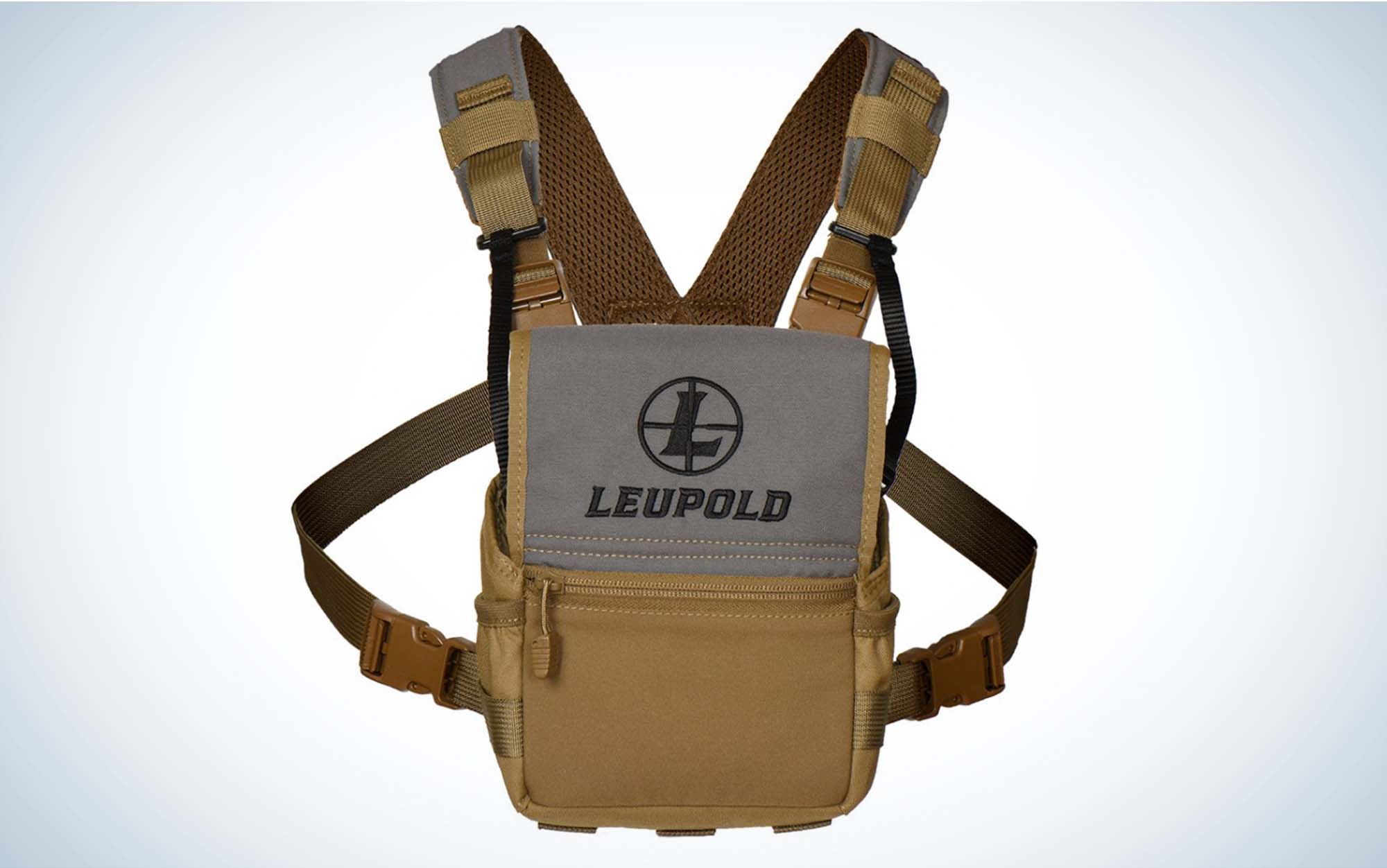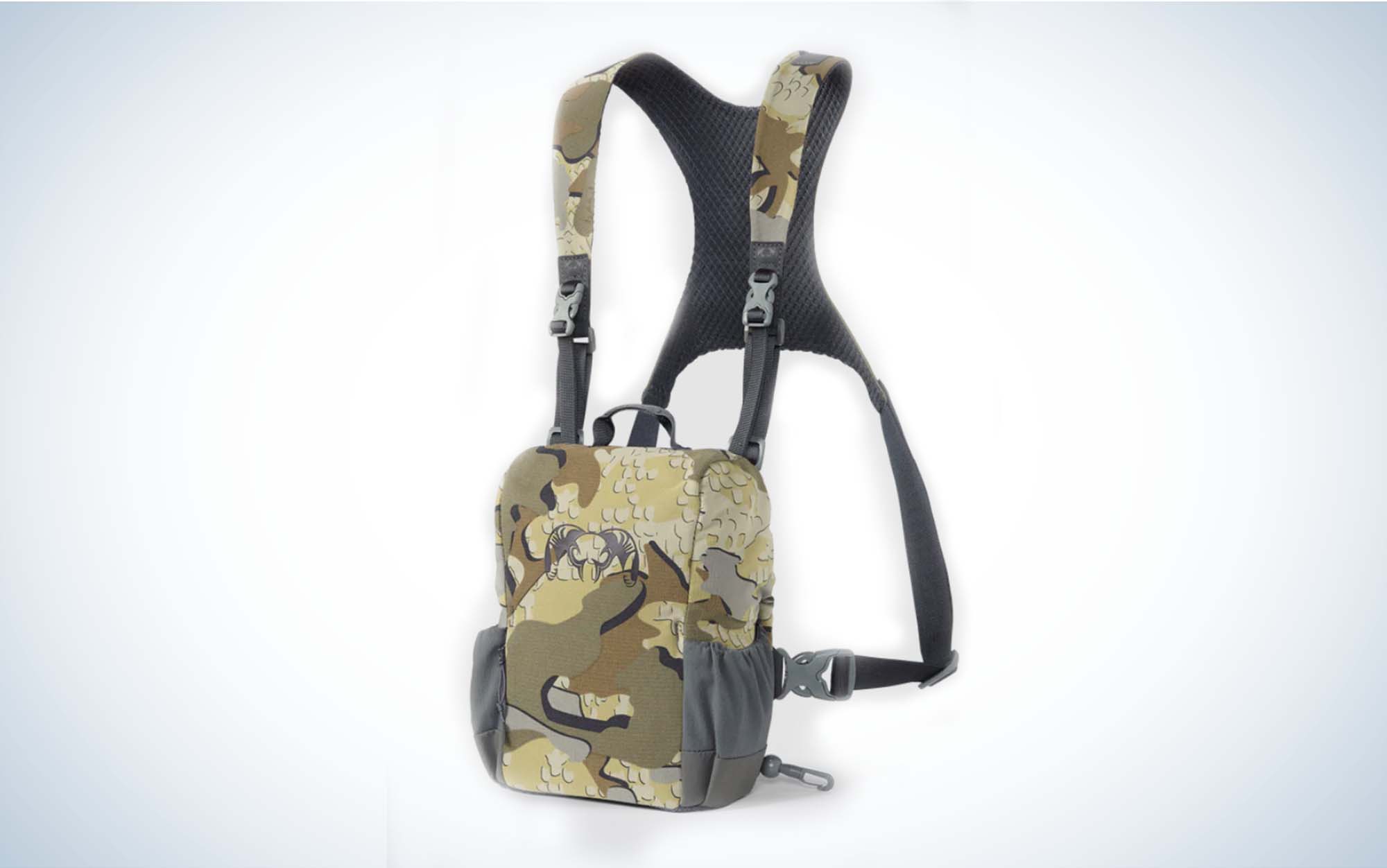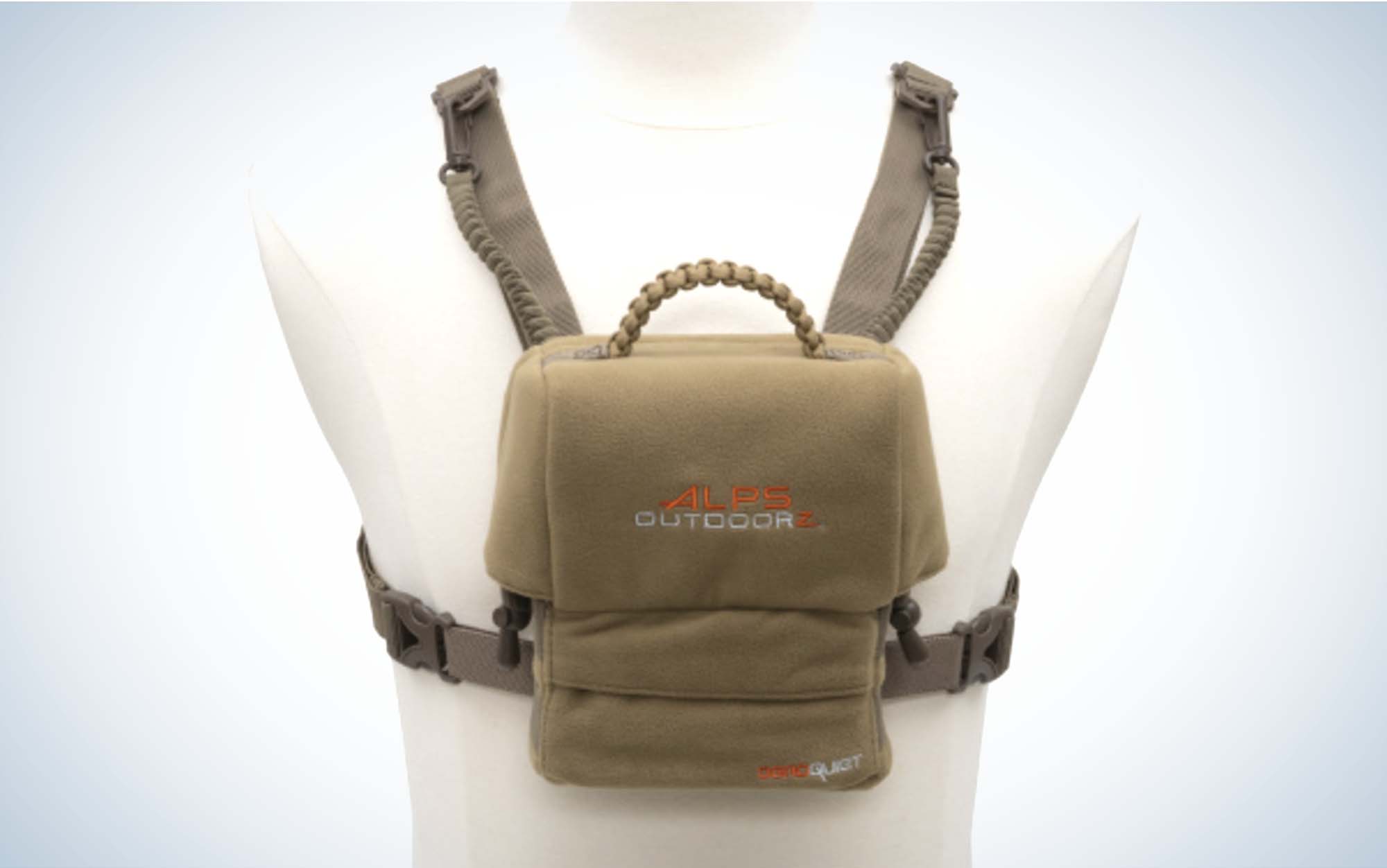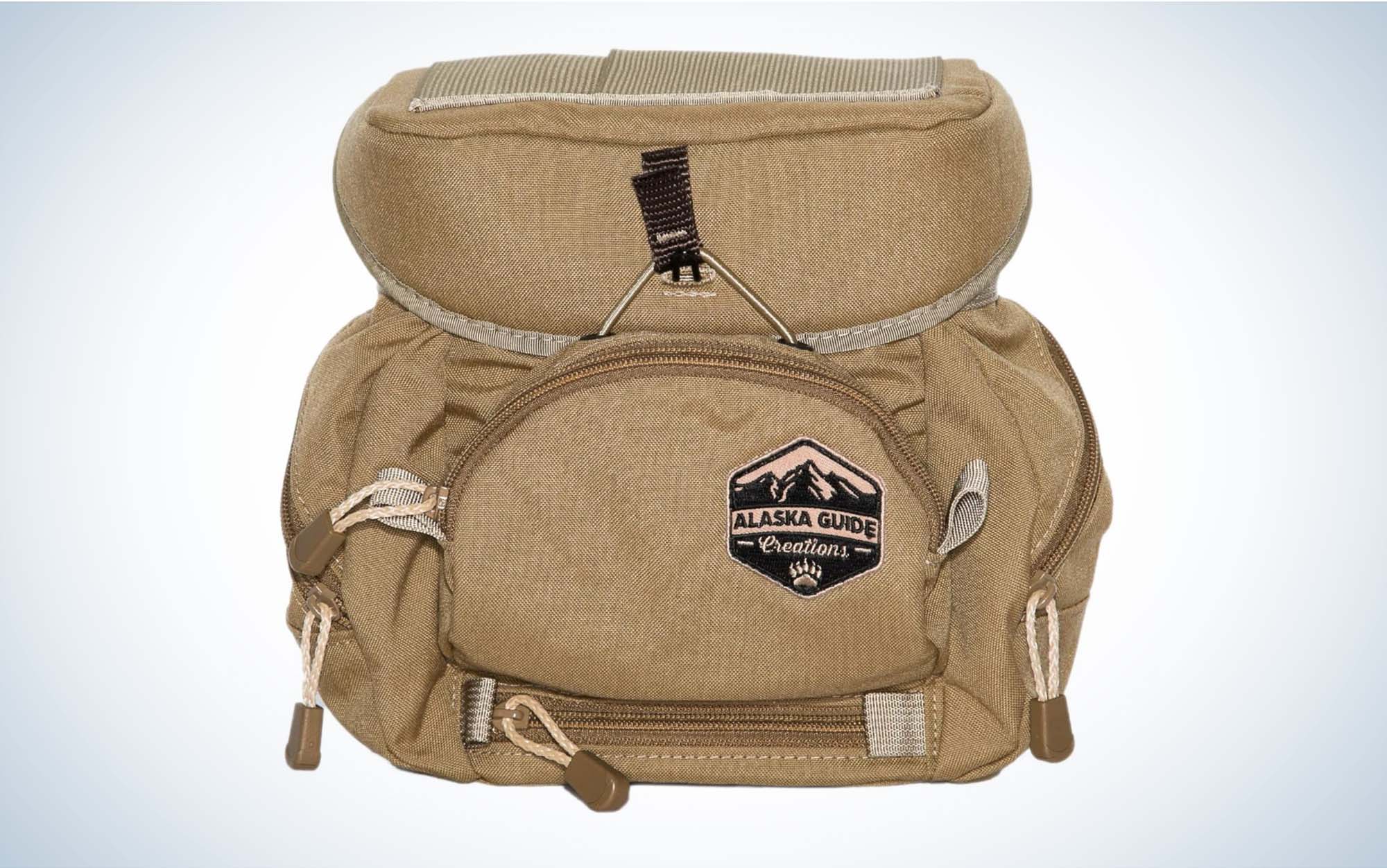We may earn revenue from the products available on this page and participate in affiliate programs. Learn More ›
Written By
Andrew McKean
Published Aug 16, 2023 1:43 PM
An earlier generation might have considered binocular harnesses as luxury items, frivolous contraptions of stitching and foam. But along the way, they’ve become essential pieces of our hunting, hiking, and outdoor recreation kit. How else would we carry a binocular—protected from the elements—along with a laser rangefinder, our phone, an elk or coyote call, plus maybe bear spray and a handgun, than in these handy chest packs that allow our hands to carry everything except our optics?
The simple answer: we’d be helpless without these handy, versatile pouches. The industry, recognizing that most of us will happily spend $125 or more on the right harness, has produced such a wide variety of designs and capabilities that it can be hard to know which binocular carrying system is right for you.
We’ve been in the same situation, unsure of which brand and model will fit our binocular, plus accommodate rangefinders, mobile phones, bear spray, and other necessities. So we tested nearly a dozen bino harnesses while belly crawling, listening for faint sounds, accessorizing them with pouches, and using them to protect a wide variety of optics. We hope our review will help you the way it helped us: to decide which of the best binocular harnesses is right for your style of hunting.
How We Tested the Best Binocular Harnesses
We subjected every submission to the same series of inquiries and indignities. Our team fitted each model to their particular torso, then we loaded the main pouch with a size-appropriate binocular and added rangefinders, bear spray, accessories, and even handguns as the model allowed.
We conducted a “dry” run, seeing how each model fit, whether any straps flapped or slipped, and how customizable each model was to every tester’s frame. In this portion of the test, we measured the quietness, abrasion resistance, and modularity of each model.
Then we added any accessories that brands sent with their flagship bino harness and assessed the comfort, versatility, durability, and protection during our dynamic drills. We jogged with each unit on our chest, crossed a fence that required some awkward calisthenics, crawled through an obstacle course, and then shot prone while wearing the harnesses. These drills allowed us to assess the protection of the optic, and durability of the material and to determine how well they accommodated the range of movement. This test also assessed how much bouncing, sag, and movement each harness allowed while we moved dynamically.
We assessed each submission on these criteria: material, adjustability, comfort, durability, modularity, optic protection, accessibility, versatility, style, and value. We combined protection and accessibility to arrive at a numeric score. Same with adjustability and comfort, and versatility and modularity. Then we rated durability and style. And finally, each submission earned a price/value score.
To earn an “Excellent” grade, the average of that category must be 9 or higher, which is extremely hard to achieve. “Very Good” is an average score of 7 to 9. A “Good” grade is 5 to 7. Our “Fair” grade is 3 to 5, and “Poor” is anything under 3.
The highest overall score won our Editor’s Choice award as the top binocular harness. The highest price/value score won our Great Buy award. We also recognized other harnesses for singular achievements.
Best Binocular Harnesses: Reviews and Recommendations
Best Overall: Eberlestock Recon Modular Bino Pack
Score Card
- Protection/Accessibility: Very Good
- Adjustability/Comfort: Excellent
- Durability/Material/Style: Very Good
- Modularity/Versatility: Excellent
- Price/Value: Excellent
Key Features
- Magnetic forward pull bino pouch
- Large front zipper pocket
- Stretch side pockets
- MOLLE-compatible wings enable modularity
- Available in medium and large sizes and six colorways
Pros
- Extremely modular
- Elastic bino tethers
- Excellent adjustability
- Comfortable padded shoulder straps
- Useful MOLLE and Velcro rear panel
Cons
- Poor rangefinder protection
- No bottom magnet to hold open lid
The consensus pick as the top binocular harness in our field, the Eberlestock Recon offers excellent binocular protection, but its main asset is the ease with which accessories attach to the base unit. We added a laser rangefinder pouch to one wing, a fleece-lined hand warmer pocket below the optic pouch, a bear-spray pouch, and an accessory pouch that would be useful for a knife, ammunition, or a communications device.
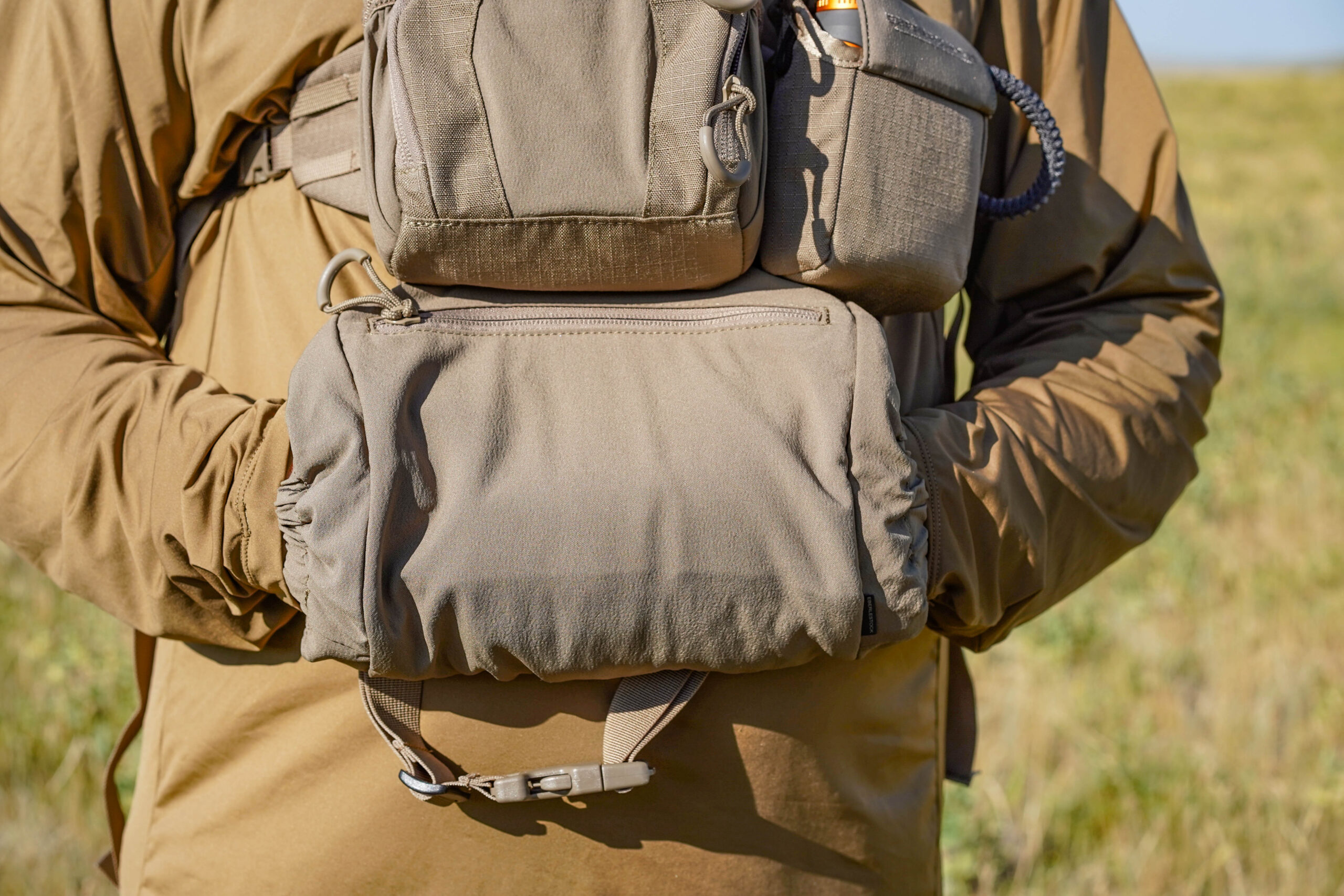
The Recon won high marks for its comfortable and extremely adjustable forward-pull shoulder harness, its durable material that has decent sound muffling, and its wide range of accessories. The strap system fit every test-team member, with enough strap extension to fit a puffy jacket for cold-weather hunting.
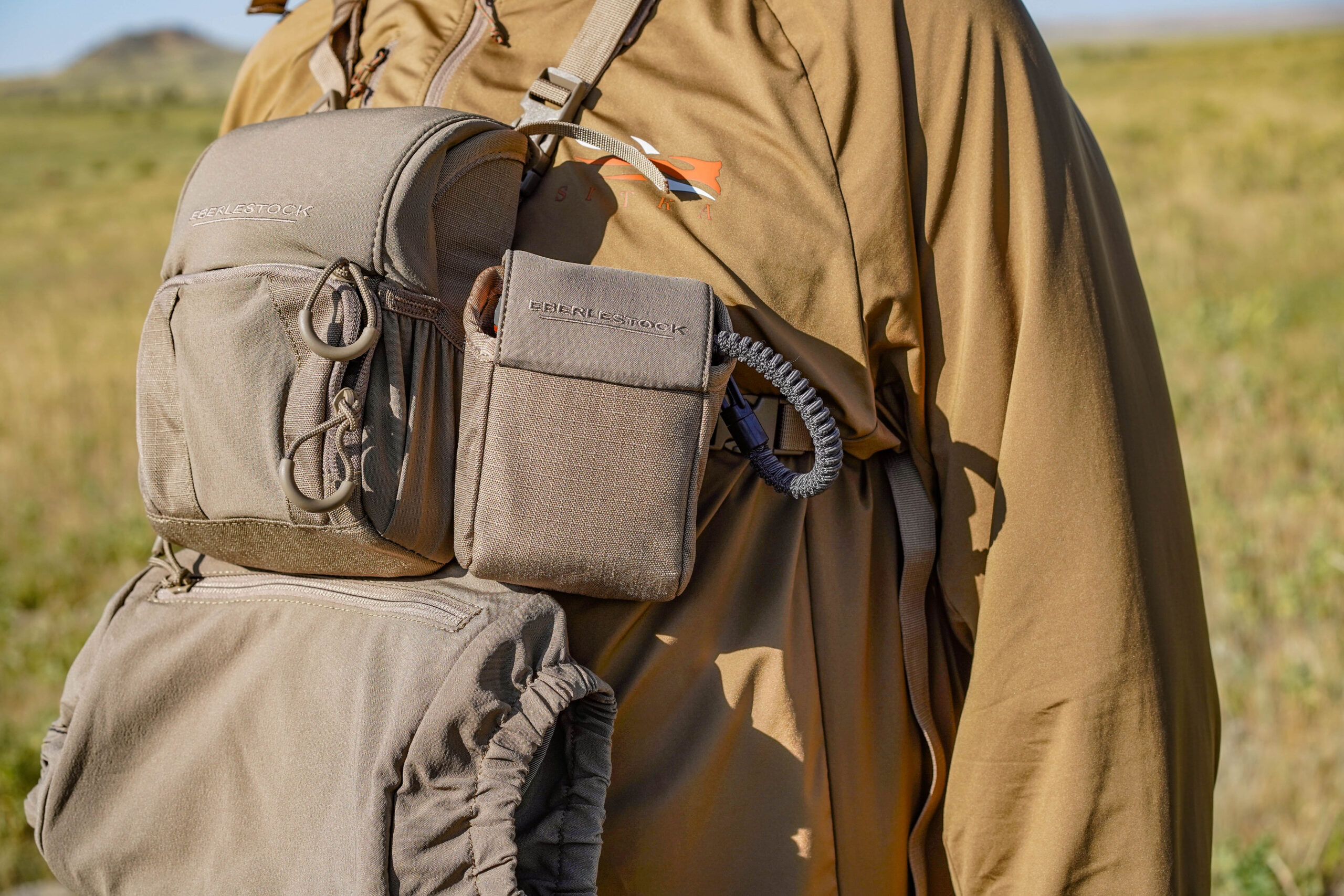
During our prone-shooting, crawling, and bounce testing, the Eberlestock did not sag or shift, and even with attachments, did not limit arm rotation. Testers liked the additional bear-spray pouch but wondered if it would fit large-diameter cans. The rangefinder pouch doesn’t add much protection, and testers want to see a better strap on the lid of the optics pouch. “The lift handle is not ergonomic,” says tester Luke Coccoli. “I found I had to twist my wrist in order to pinch the flap to open it.”
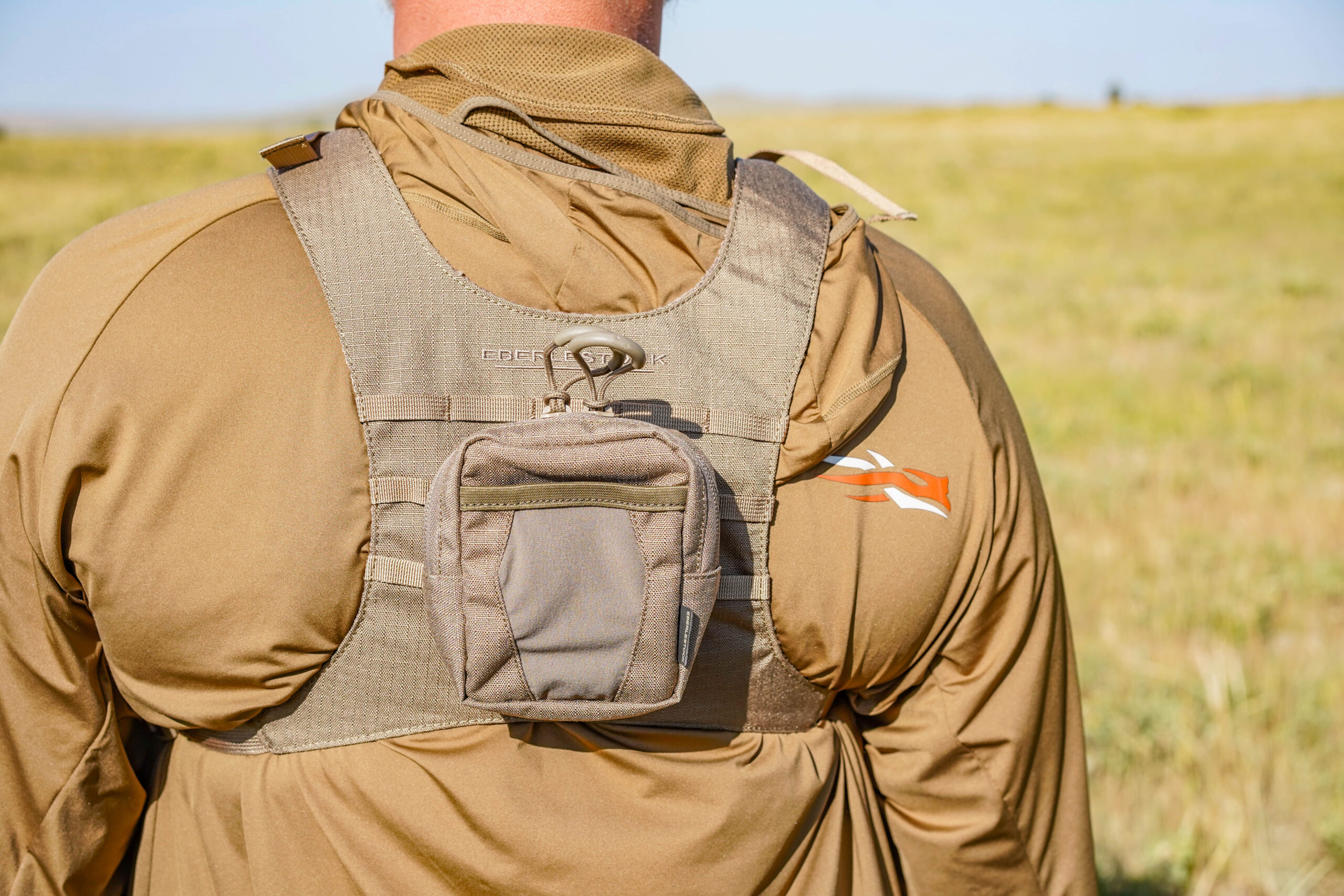
But those are fairly small quibbles. The base Recon does its job, carrying and protecting a binocular, with style and ease, and is one of the best all-around binocular harnesses our testers have ever encountered. And, at about $130, it’s a very good deal for an amazing amount of performance.
Read Next: Best Binoculars for Hunting
Best Value: Badlands Bino Mag2
Score Card
- Protection/Accessibility: Very Good
- Adjustability/Comfort: Very Good
- Durability/Material/Style: Very Good
- Modularity/Versatility: Good
- Price/Value: Very Good
Key Features
- Stay-open magnetic lid
- Rear magnetic-closure pocket
- Quick-release carabiner rings
- Bow hook
- Bottom accessory attachment points
- Three sizes and four colorways
Pros
- Lid offers very good protection
- Magnetic closure is quick and durable
- Bow hook is extremely useful
- Updates venerable design
- Breathable suspension straps
Cons
- Magnetic closure can be loud
- Bottom attachment insufficient for bear spray
- Among the “bounciest” units
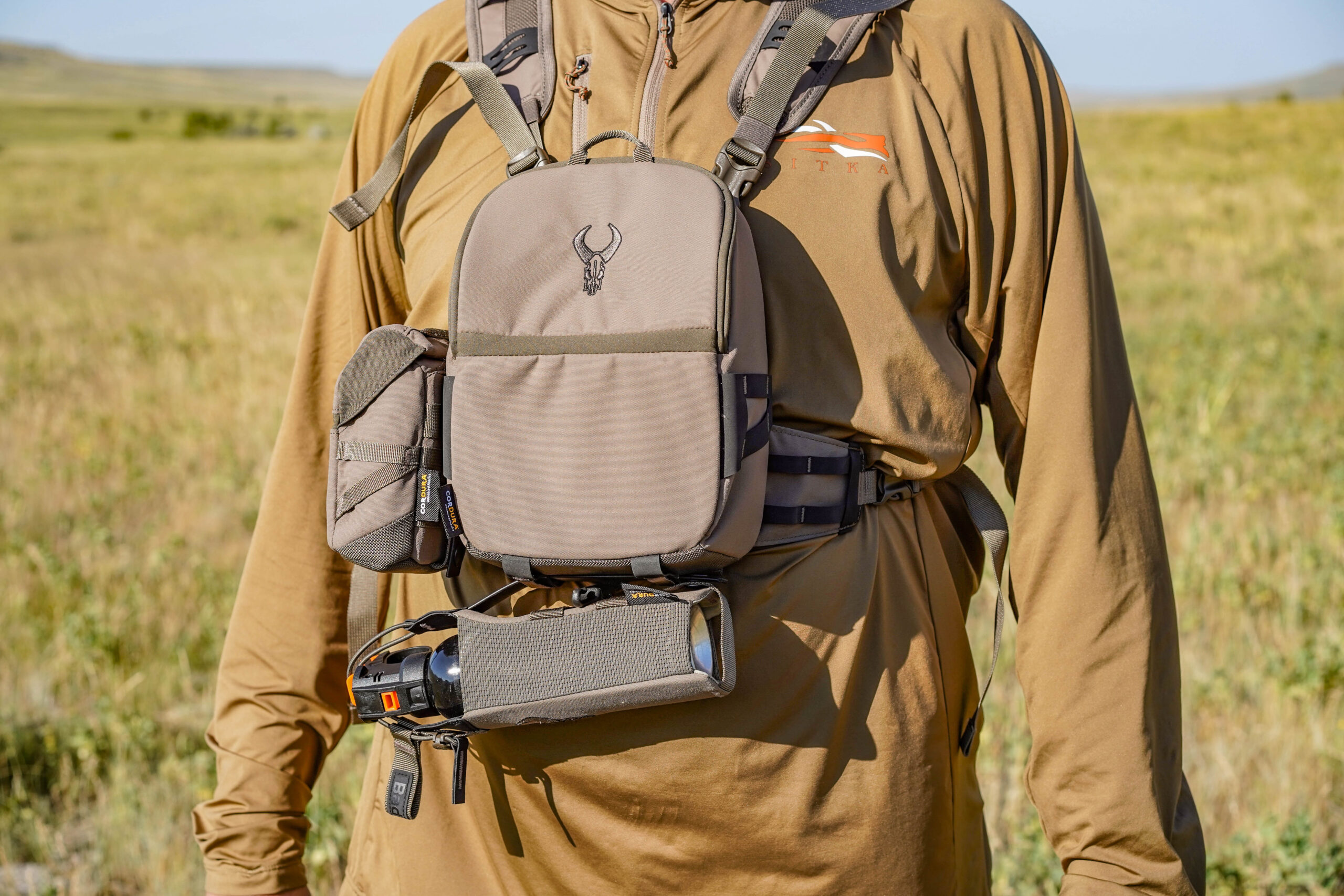
The original Badlands magnetic-closure bino harness has become an OG of the industry. It led the, um, pack in terms of inventing a useful, extremely portable and protective house for binos of just about any size. The new Mag2 brings some useful updates to its predecessor. A secondary magnet holds the lid open, and the buckled attachments enable Badlands to add a spacious rear pocket, also held closed with a magnet, behind the main optic compartment. This is a useful pouch for a phone, folded map, or a portable power pack.
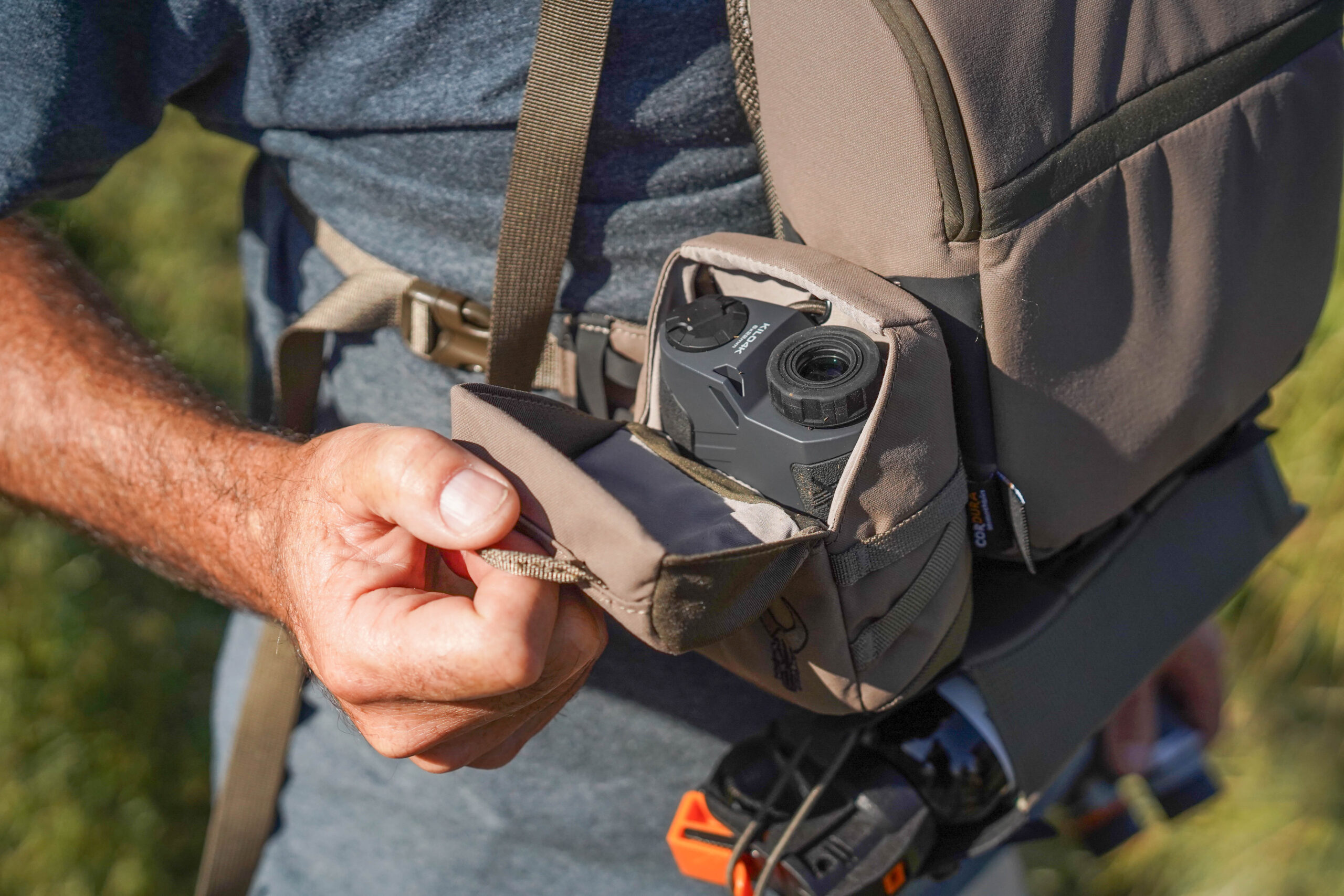
We like the breathable mesh that is sewn onto most surfaces that contact the body. And Badland’s bow hook, which enables archers to clip their bowstring right to the bottom of the pack, leaving hands free to glass, is genius and effective; we recommend other manufacturers consider this simple accessory. The main optics pouch has attachment points on either side, and wings as well as bottom connections allow for further attachments.
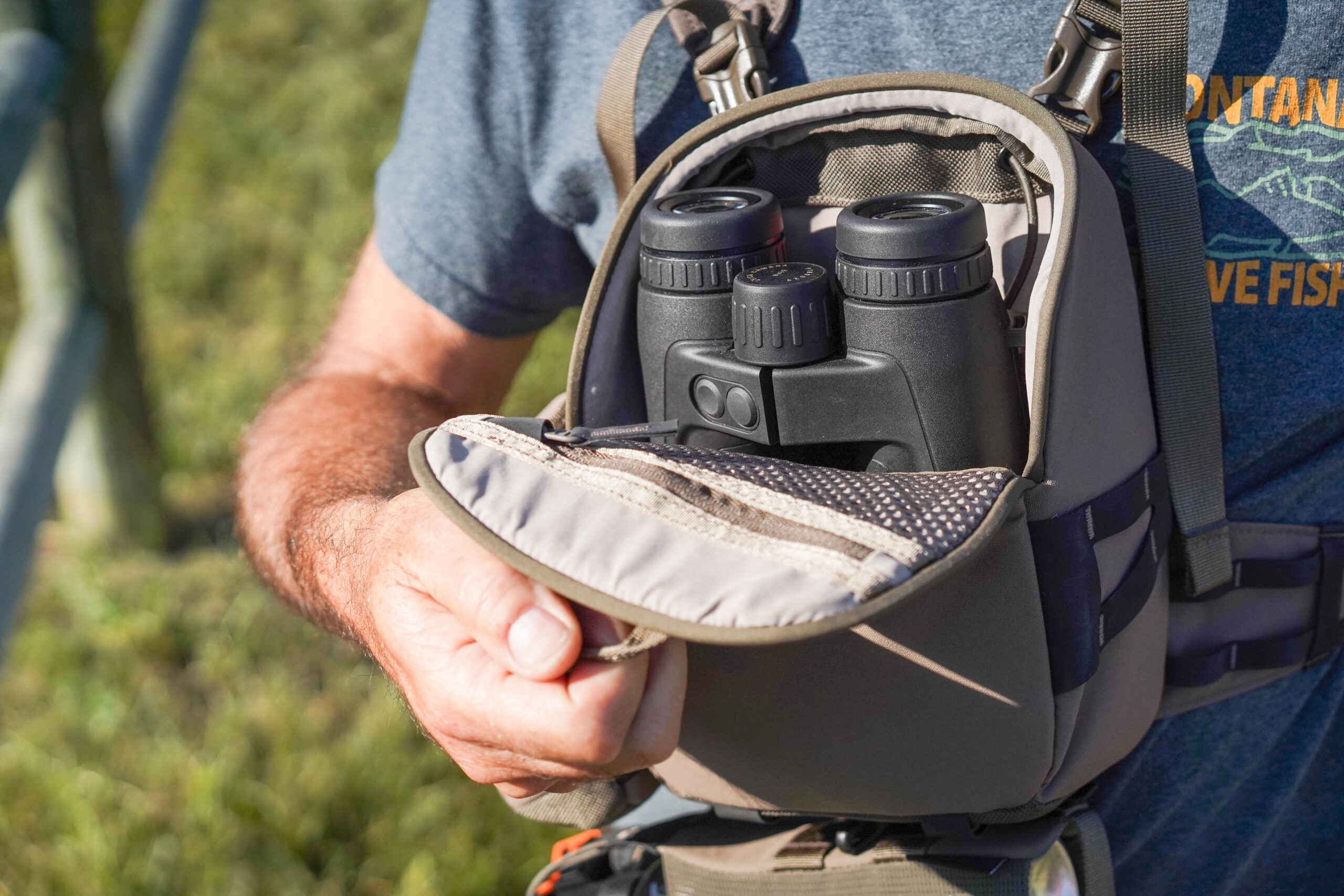
We played around with various configurations, attaching accessories both horizontally and vertically, and determined that the bear spray attachment isn’t secure enough for vertical use. Some testers felt the rangefinder pouch—which features the same double-magnetic closure that Badlands uses for its main optics pouch—was hard to reach in a sideways orientation. Happily, all pouches have enough attachment points that they can be configured just about any way a user wants, though getting them tight enough that they don’t flop is a challenge.
The test team had mixed reviews of the metal carabiner rings used to attach and detach optics quickly. Most felt they were overly heavy, others felt they were a very useful asset.
The Mag2 was one of the bounciest units in our test of the best binocular harnesses, probably because the straps tended to slip and move as a result of the breathable “AirTrack” suspension material. But given the level of optics protection and the ease of using the magnetic lid, the new Mag2 is an excellent update to an old favorite. And, at about $140, it’s a whale of a lot of value for the money.
Read Next: Best Binoculars for the Money
Sitka Mountain Optics Harness
Score Card
- Protection/Accessibility: Very Good
- Adjustability/Comfort: Very Good
- Durability/Material/Style: Very Good
- Modularity/Versatility: Very Good
- Price/Value: Good
Key Features
- Three modular pouches
- Silent magnetic front flap for bino pouch
- Elastic side pockets
- Quiet brushed polyester face fabric
- One size, four different colorways, including Sitka’s camo patterns
Pros
- Two-position magnetic flap with keepers
- Quick-detach bino attachments
- Very light weight
- Easy access to optic and accessories
- Elastic keepers on accessory pouches are quiet and quick
Cons
- Uncomfortable and tangle-prone straps
- Beyond the three-pouch arrangement, difficult to add accessories
- Optics pouch doesn’t fit very large frame binos
Despite looking like a chest rig a paratrooper might wear and built with more straps than a Golden Girls girdle, this optics-and-accessories kit from Sitka is one of the most protective and useful harnesses on the market. While it’s designed to be modular—the two smaller pouches that come as a unit with the main optics pouch can be removed—we found all three worked extremely well together.
The heart of the Mountain Optics Harness is the spacious binocular pouch that is protected by one of the smartest and quietest magnetic lids in the business. The lid itself has two attachment points to accommodate smaller and larger-framed binoculars, though we had a hard time getting 15×56 models to fit. The lid articulates, enabling either full protection from the elements or fast deployment of a binocular. Elastic side pockets are great for elk calls, wind-checking powder, or knives.
The two pockets feature elastic closures that are fast and quiet. We used one for a laser rangefinder and the other for an InReach or cell phone. They’re boxy-looking but spacious enough to be used for any number of accessories. We also liked the brushed fabric that faces all the pouches, making the Sitka pack one of the quietest in our test. The hard shell covers do a good job of protecting a rangefinder from the elements, though one tester wished one of the smaller pockets had the same bi-folding magnetic lid as the optics pouch.
Our biggest gripe with the Sitka is the strap system. The unit deploys two non-padded straps that cross over the back and then buckle into the sides. The straps are easy to tangle and twist and make taking the unit on and off a bit of a chore. But the strap system performed well in our bounce, prone, and crawling tests.
Best Optics Protection: Marsupial Enclosed Binocular Pack
Score Card
- Protection/Accessibility: Excellent
- Adjustability/Comfort: Good
- Durability/Material/Style: Very Good
- Modularity/Versatility: Very Good
- Price/Value: Good
Key Features
- Double-magnet stay-open lid
- Stretchy front zippered pocket
- Stretch side pockets
- Rear cell phone pocket
- MOLLE attachments on bottom
- Fleece liner for silent deployment
- Three sizes and 10 colorways
Pros
- Easy one-handed operation
- Lots of accessories: rangefinder pouch and tether, zippered pouch, bottom mount holster
- Sturdy zippers and buckles
- Spacious binocular pouch
- Excellent optics protection
Cons
- Poor rangefinder protection
- Hard to use with bulky layers
- Exterior material is fairly loud
Termed by one tester as the “Cadillac of the group,” the Marsupial Chest Pack offers excellent protection for optics and a very useful one-hand access via the magnetic lid. Breathable mesh faces most surfaces that contact the body, including the shoulder straps and the back of the optics pouch. We loved the spacious phone pocket on the rear of the pouch, and the elastic pockets accommodate a wide range of small gear, from mouth calls to extra shells to batteries.
The high sidewalls are an important and excellent addition to the design. Try as we might to get dust and debris into the optics compartment, the tight-fitting lid and walls kept binoculars of various heights dry, safe, and secure.
Accessories included a rangefinder pouch with the same magnetic lid as the main optics compartment, a rangefinder tether, and a very useful zippered pouch that has webbing for internal organization. We also liked the quick-detach optics straps integrated into the shoulder harness.
Demerits included the rangefinder pouch, which needs a second attachment loop. Our pouch was top heavy and tipped away, causing some consternation when crawling. The straps irritated the necks of some testers, and others felt the straps would be too short to fit over winter jackets. Lastly, the unit was bouncy and sagged a bit on our crawl.
But the components are among the best in our test, and if the unit looks a little boxy, it’s spacious enough for a wide range of optics that benefit from the best protection in the test.
FHF Gear FOB Bino Harness
Score Card
- Protection/Accessibility: Very Good
- Adjustability/Comfort: Good
- Durability/Material/Style: Very Good
- Modularity/Versatility: Very Good
- Price/Value: Good
Key Features
- Tri-fold magnetic lid
- Breathable Airframe shoulder harness
- Quiet nylon exterior
- Fleece-lined interior
- MOLLE panels on sides and bottom
- Zippered stretch front pocket
- Two sizes and six colorways
Pros
- Includes wind/call pouch
- Excellent oversized lid handle
- Foam blocks for customizing internal dimensions
- Optional wings add accessory attachment points
- Optional rain cover should be copied by competitors
Cons
- Scratchy straps
- The lid falls forward if not fully closed
- Sags while crawling
The most expensive harness in our test, the FHF Gear FOB (Forward Operating Base) Harness, is a feature-rich stand-alone unit but really shines when the optional Foundation Wings are added to the sides. Those wings offer additional attachment points for the brand’s full line of accessories, including a couple of different rangefinder pouches, a utility pouch, a bear-spray holster, and a MOLLE-webbed “Nav Pouch.” Our kit—we tested both the large and medium models—included the wings and the M1 rangefinder pouch. As an aside, the $25 wings are so useful that one tester wondered why they don’t come standard.
The heart of the FOB Harness is its tri-fold magnetic lid, which has a secondary magnet to either hold it open at full extension or folded on itself. Inside, the pouch is lined with noise-dampening fleece, and the unit comes with a stack of foam inserts. Users can adjust the number of layers to the height of their binoculars, meaning that optics won’t flop around in the chamber. The pouch’s exterior is faced with quiet material, making this an excellent choice for close-quarters bowhunters. We loved the buckle covers on the straps, which further minimized clanking noise. We’d like to see some way to remove the side buckles when the wings are attached; we found those vestigial buckles rubbed and clanked against our belts and pack frames. The skeletonized shoulder straps keep users cool, but most testers complained the straps rubbed against their neck.
The oversized handle on the top of the lid is the best in the test; in fact, many testers wanted to use that same design on competitors’ models that have a maddeningly small tab to deploy the lid. The FOB Harness lid uses three closure magnets, providing ample protection from the elements.
We like the front zippered pocket, which to our surprise, contained a small accessory pouch that’s sized to accept a wind-indicator bottle and mouth call, another amenity that bowhunters will appreciate. The rear mesh pocket fits a phone, though users should note that it won’t be protected from the elements.
With the wings, our rangefinder pouch—which also uses a magnetic lid—fit much better than on the sides of the optic pouch. The FOB makes a lot of use of MOLLE, but their particular design has tediously small openings.
The FOB lost points on our active-movement test. It bounced badly on our jogging course, wasn’t particularly comfortable while prone, and was described as a “mega-sagger” on the crawling phase of the test.
Read Next: Best Rangefinders for Hunting
Badlands Bino X2
Score Card
- Protection/Accessibility: Very Good
- Adjustability/Comfort: Good
- Durability/Material/Style: Good
- Modularity/Versatility: Very Good
- Price/Value: Good
Key Features
- Stay-open magnetic lid
- One-hand operation
- Rear magnetic-closure pocket
- Elastic side pockets
- Zippered elastic front pocket
- Breathable suspension
- Three sizes and four colorways
Pros
- Quick-release carabiner rings
- Badlands bow hook
- Side and bottom attachment points
- Positive magnetic closure
Cons
- Closure can be loud
- Two hands required to tuck the lid lip
- Fairly small optics pouch
New for the year, this is the little brother to the new Badlands Mag2 and is a more minimalistic option that has the same positive lid closure and secondary pockets. Like its predecessor, the magnetic lid is the value proposition for this harness. The lid deploys with one hand, and we loved the grabby pull that facilitates operation. A second magnet keeps the lid open.
The test team was divided on the utility of the heavy metal carabiners, which act as quick-release attachments for optics. Half loved their fast deployment, and half felt they were too heavy and unnecessary. “A zip tie would work just as well,” he said.
For a go-light hunter, there’s everything you need on the base pouch: two side pockets for calls and spare shells, a zippered front pocket for larger items, and a roomy rear pocket that has a magnetic closure and fits larger items like cell phones. The X2 also has smart attachment points on the sides and bottom for additional accessories like rangefinders, pistol holsters, and bear spray.
The small stature of the X2 allowed for very mobile deployment in our dynamic testing. We recorded minimal sag on our crawl and prone courses but did measure noticeable bounce on our jogging course. It’s very comfortable to wear while laying prone, but because the bottom dimensions are fairly small, we had a hard time getting our bear spray holster to fit well.
Stone Glacier Skyline Bino Harness
Score Card
- Protection/Accessibility: Very Good
- Adjustability/Comfort: Good
- Durability/Material/Style: Very Good
- Modularity/Versatility: Good
- Price/Value: Good
Key Features
- Waterproof laminate material
- Lightweight: 8.8 ounces
- Forward-opening lid
- Ultra-quiet operation
- Low-profile design
- Two sizes and two colorways
Pros
- Minimalist design
- Side and back pockets
- Highly adjustable
Cons
- Flimsy straps
- Minimal attachment points
- Minimal optics protection
This harness is designed for ultralight hunters who favor mobility over protection. At just 8.8 ounces for the regular size (9.7 ounces for the large model) and made from thin, technical material that’s designed to be quiet rather than bomb-proof.
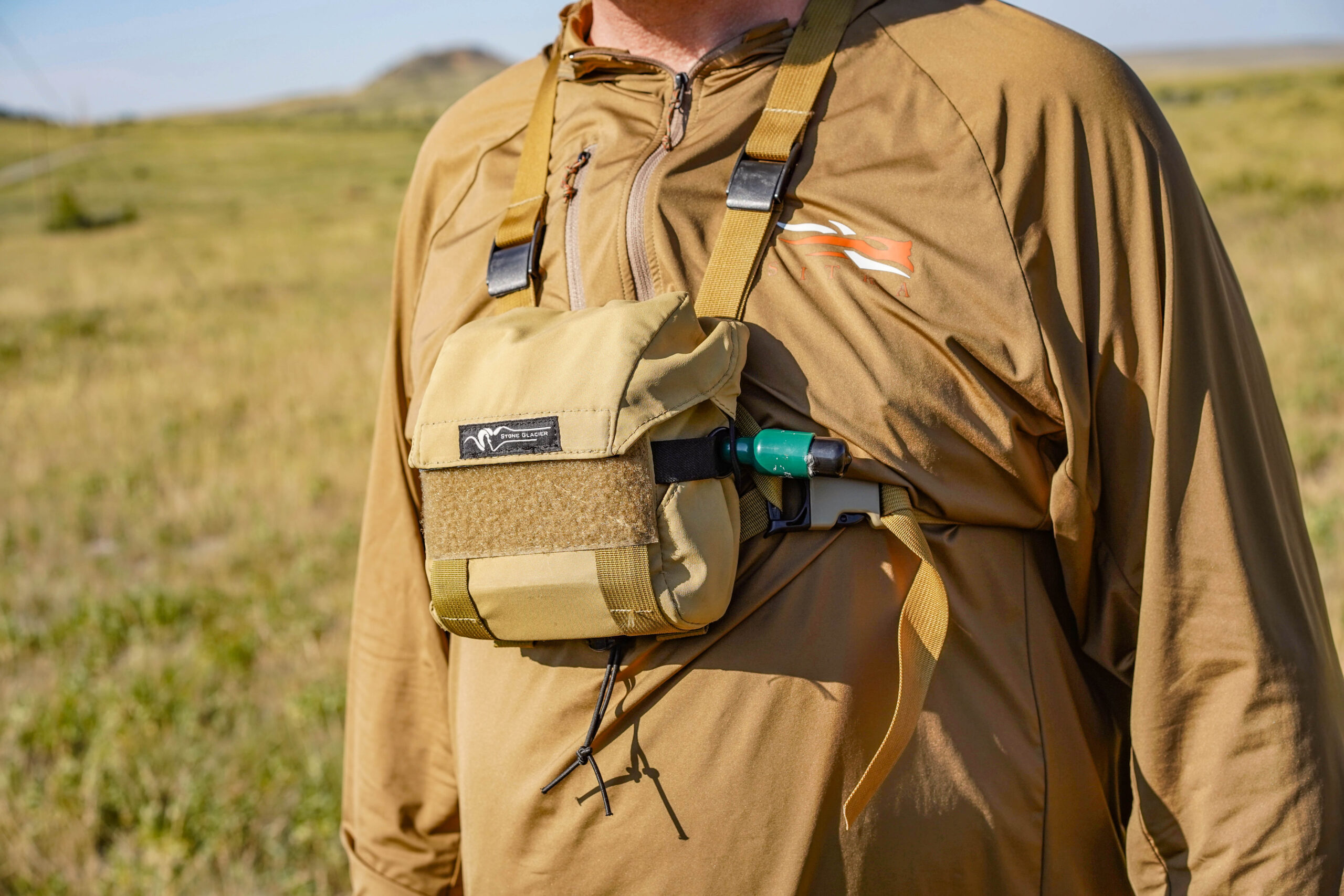
The Skyline requires some pre-work to get the right fit for your optic. Velcro-ed panels adjust to the height of your binocular, creating a snug fit. The lid, adjusted via elastic straps, lifts and pulls forward to deploy the optic. It’s a quiet, fast system, but it doesn’t protect optics from dust and moisture as well as fully fitted lids.
Our dynamic testing revealed the attributes of this design. The Stone Glacier harness didn’t sag or bounce. It was comfortable while prone, and larger hunting packs fit nicely over the small pouch. But attachment points are equally minimal, and we had a hard time getting the Eberlestock bear-spray holster to attach, though it must be said that the Badlands holster attached with ease. With two side pockets and a rear pocket, there’s some ability to carry calls, shells, and other small items on this binocular harness, but as they say on most airplanes these days, storage space is limited.
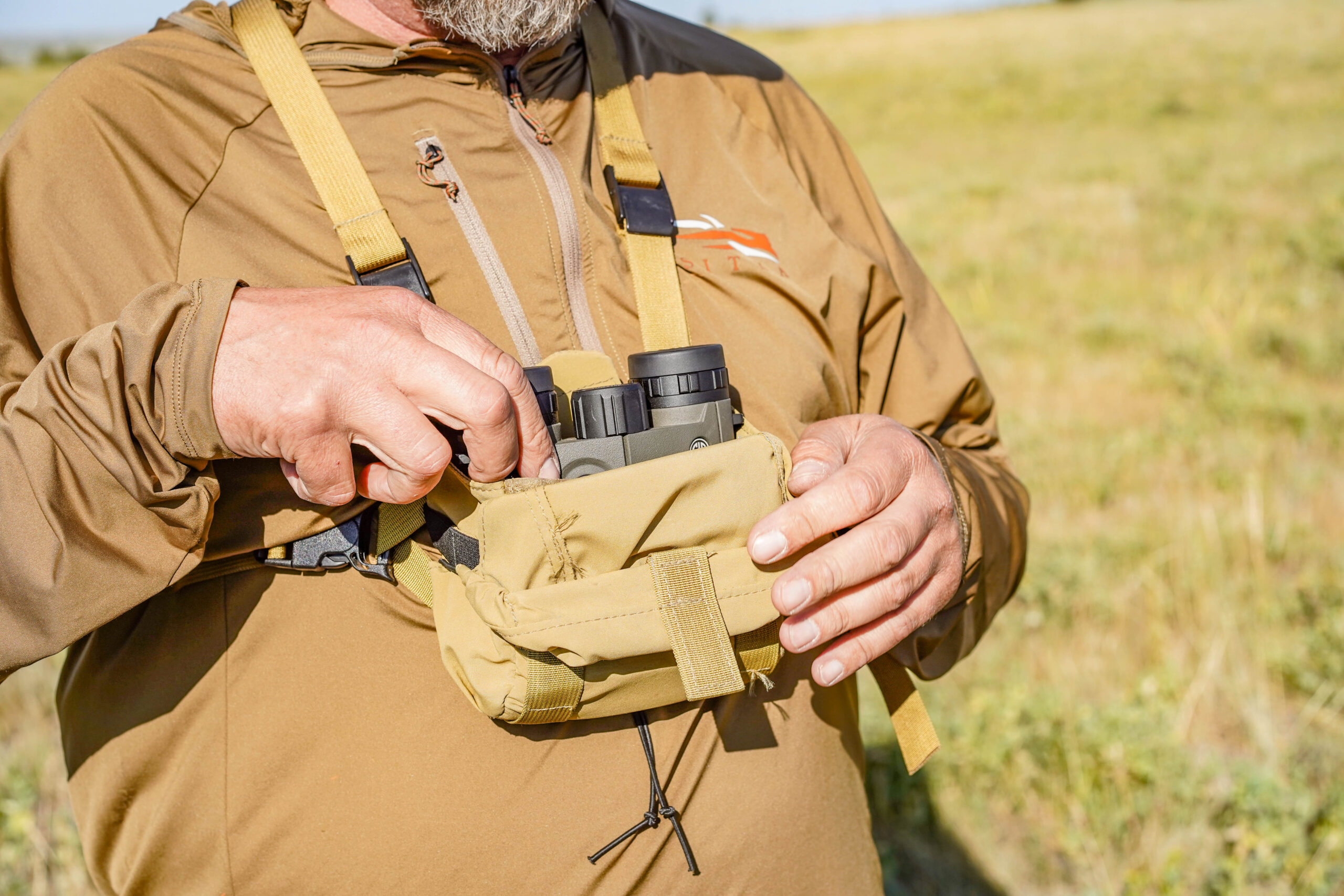
The straps are as spartan as the pouch and might not fit every torso, and one OL tester cursed the weak tension chest-strap buckles. Other testers wanted at least one zippered pocket. But for active hunters looking for a light, svelte binocular harness, this deliberately under-engineered model is a good choice.
Leupold Pro Guide Binocular Harness 2
Score Card
- Protection/Accessibility: Good
- Adjustability/Comfort: Good
- Durability/Material/Style: Very Good
- Modularity/Versatility: Good
- Price/Value: Good
Key Features
- One-hand operation
- Strong magnetic closure
- Elastic side pockets
- Zippered elastic front pocket
- Rear cell phone pocket
Pros
- It fits most binoculars smaller than 15x
- Quiet fleece lining
- Breathable mesh straps
Cons
- Poor optics protection
- Magnetic closure is loud
- Minimal attachment points
A good basic harness, this unit will tote just about any sized binocular and offers enough on-board storage for a day afield. A spacious rear mesh pocket will carry a phone, and the side pockets are perfect for earplugs, extra shells, or mouth calls. The front pocket holds just about any other sundry. The one-hand operation of the strong magnetic lid is easy to deploy but users have to be conscious that the strong magnet can clack if it isn’t eased open.
We liked the roominess of the pouch and the aggressive Leupold branding. But testers had their share of gripes. Mainly, they wanted more and better attachment points for accessories. We snapped on a rangefinder pouch, which has the same smart magnetic lid, but it sort of swayed and got in the way. We also felt that the large openings between the pouch’s sidewalls and lid provided too much opportunity for dust and moisture to affect the optic.
It’s not a technical piece of kit, but it’s also not intended to be. What it does well is accommodate a wide range of binocular types and sizes, its straps fit a wide variety of torsos, and the unit is easy and quick to deploy.
KUIU PRO Bino Harness
Score Card
- Protection/Accessibility: Fair
- Adjustability/Comfort: Good
- Durability/Material/Style: Good
- Modularity/Versatility: Fair
- Price/Value: Good
Key Features
- Moldable, customizable lid
- Waterproof TORAY stretch nylon
- Quiet fleece interior
- Zippered front pocket, two elastic side pockets
- Two sizes and five colorways
Pros
- One-hand operation
- Removable foam shims for customized fit
- Velcro bottom panel for attaching accessories
- Quick-detach binocular straps
Cons
- Torso straps are hard to tighten
- Two hands required to close the lid
- Uncomfortable to use while prone
- No rear pocket
If protection of the on-board binocular is the main job of a harness, then the KUIU gets very high marks. Its tension-designed lid fits snuggly over the sidewalls and provides tight cover from debris and moisture. Another attribute in the plus column is the excellent pouch, which is lined in fleece to minimize noise and includes removable foam shims that allow users to adjust the size of the pouch to their binocular.
The PRO Bino Harness has adequate additional storage between the two elastic side pockets and the small zippered front pocket. We would like to see a rear pocket to accommodate a phone.
Our main gripe was the straps, which were hard to get tight and seemed to attach to the pouch at odd directions and angles. The elastic keepers that provide tension for the lid are similarly persnickety; they require a fair bit of trial and error to get the fit just right. If the lid is easy to deploy with one hand, it took most of us both hands in order to get the lid back over the pouch. Besides a Velcro panel on the bottom that accepts accessories like holsters for guns or bear spray, there are few attachment points for a rangefinder holster or accessory pouches.
In our dynamic drills, the harness bounced and sagged considerably and was uncomfortable to wear in the prone position.
But the KUIU is light—only 11.8 ounces for our large size—and highly mobile. And the design and material should keep your optic safe from the elements at any elevation.
ALPS Outdoorz Shield with DeadQuiet
Score Card
- Protection/Accessibility: Good
- Adjustability/Comfort: Good
- Durability/Material/Style: Good
- Modularity/Versatility: Fair
- Price/Value: Very Good
Key Features
- Quiet fleece exterior
- Suede-lined rear pocket
- Zipperless front pocket
- One-hand operation
- One size and one colorway
Pros
- Extremely quiet design
- Decent attachment points for accessories
- Tension-cord lid is easily adjustable
- Fits most 10×42 binoculars, including rangefinding binos
- Attractive price
Cons
- The lid isn’t especially protective
- Significant bouncing and sagging
- Limited utility
This may be the ultimate late-season whitetail harness. It’s designed to be dead quiet, and even noisy zippers are outlawed from the Shield. Its fleece exterior won’t amplify the scratch and snap of branches, and the lid deploys with silent ease.
But the hunt-quietly attributes are about all the Alps harness brings to the game. Its strap geometry makes it hard to suck up tight and low, and contributed to the significant bouncing and sagging in our dynamic-drill test. In order to get the harness super tight to the torso, the pouch rides up near the chin. The lid doesn’t fit especially tightly, and while it should keep a gentle snow or rain off your binocular, wind-driven dust and moisture could get into the pouch.
Still, the price is wonderful, and the DeadQuiet Shield pairs nicely with Alps’ Ember Hand Warmer, a required piece of gear for cold-weather hunting. We can see this binocular harness as an equally indispensable partner to late-season hunters who know that any unnatural sound is amplified in the cold, still woods of winter.
Alaska Guide Creations Alaska Classic
Score Card
- Protection/Accessibility: Good
- Adjustability/Comfort: Good
- Durability/Material/Style: Good
- Modularity/Versatility: Fair
- Price/Value: Good
Key Features
- OG of bino harnesses
- Elastic tension-cord lid
- Zippered front pocket
- Zippered side pockets
- The elastic shelf on the lid
- Two sizes and nine colorways
Pros
- Fleece lined for quiet deployment
- Shelf accepts cell phone
- Elastic MOLLE straps on bottom
Cons
- Limited attachment points
- Least modular harness in the test
- Dated design
This binocular harness hasn’t changed appreciably in nearly 50 years, and while the classic design still works for a wide range of binocular sizes and frames, it doesn’t easily accept accessories. Given the highly modular designs of more modern harnesses, that old-school design was more of a liability than an asset in our test.
Testers liked the make-do attitude of the Alaska Guide Creations’ Classic. Instead of a separate pouch for a rangefinder, it can shove into the elastic pocket on top of the lid. Instead of wanting separate pouches for shells and other sundries, they can zip right into one of the unit’s three spacious pockets. But testers also shelled the AGC’s limited accessibility, modularity, and adjustability.
“The straps need to be sewn higher on the shoulder,” said one tester. “I was happy with the lack of bounce and sag, but the unit sits so low that it’s uncomfortable in the prone position.” Another noted that the binocular pouch is too big and sloppy and that most 10×42 frames bounce around. Still, another fussed over the elastic cord that provides tension to the keeper. It kept coming loose and allowing the lid to flop open.
I’ve used my AGC Alaska Classic as a run-and-gun turkey pack for the last few seasons. I tuck a small-frame binocular into the main pouch, a pot call in the front pocket, a striker and box call in the elastic shelf, and a couple of spare shells in a side pocket. In that way, maybe it’s more useful to think of the unit as a do-it-all micro pack than as a technical binocular harness.
How to Choose a Binocular Harness
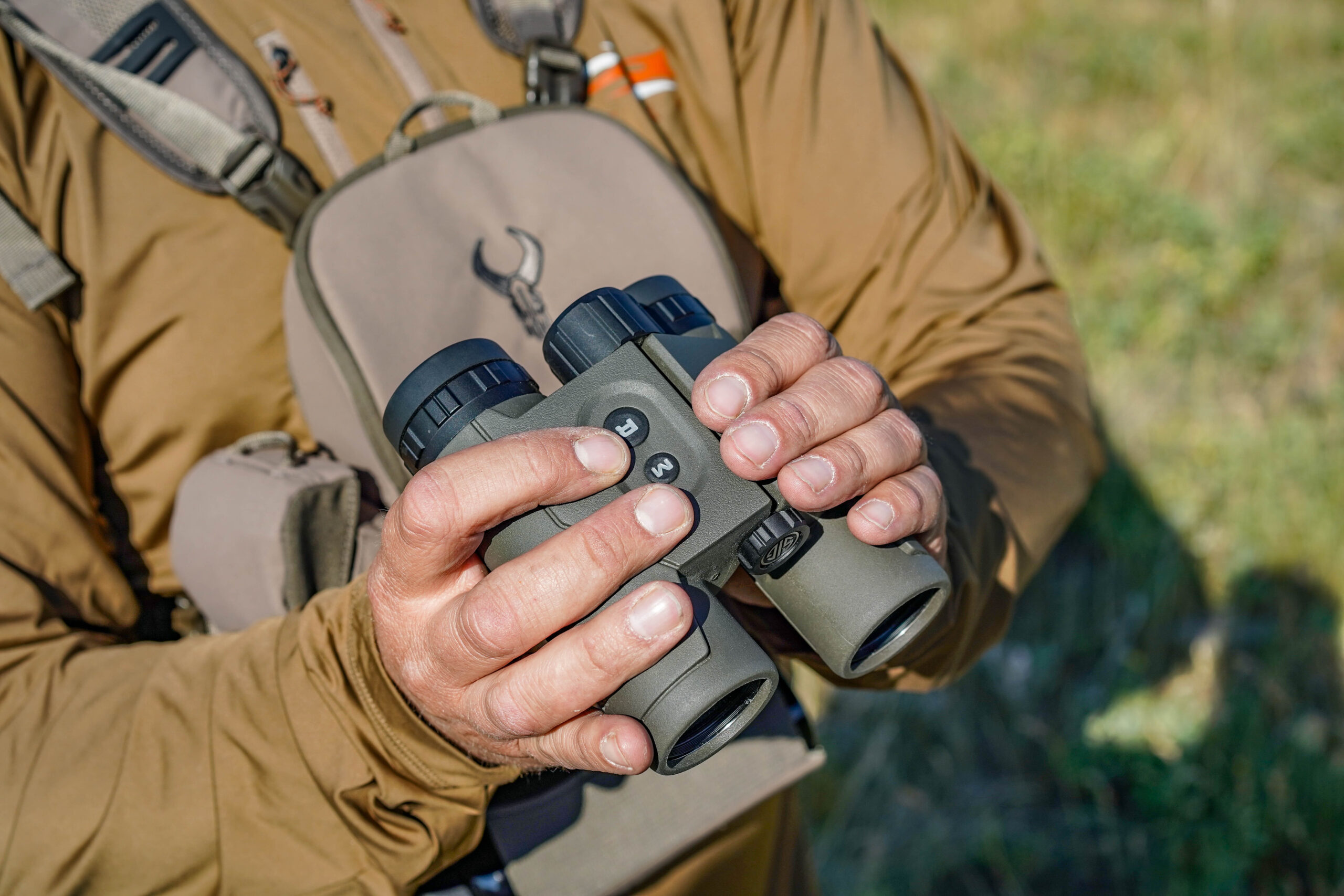
Obviously, your first consideration will be whether a harness fits your particular binocular. Most of these pouches are sized to fit a standard 10×42 frame, but check to see if they’ll fit new rangefinding bino models or optics with especially tall frames, such as Maven’s big B.2 model.

Second, think about what you want a harness to carry besides a binocular. Do you need a rangefinder pouch? Does that come standard with the bino harness, or is it an accessory that costs extra? Same with bear-spray and gun holsters, sundry pouches, and other add-ons. Make sure that the base model has plenty of attachment points for these accessories.
Next, think about your own build, and ensure that a harness will fit your particular torso. Most are built to fit a wide range of torso lengths and girths, but some have specific sizing. Also, ensure that the straps will fit you from early season shortsleeve weather to late season layering. How well does the bino harness fit beneath a pack?
Does the lid and binocular pouch offer complete protection from the elements, or only a roof with no windows? Your binocular is a precise optical instrument that will perform best when it’s protected from dust, debris, and moisture, so fully protective lids that can be deployed easily and quietly are worth an extra look.
FAQs
Do you need a binocular harness?
You don’t need a binocular harness, but using one will make it much easier to use your binoculars and have them at the ready.
What features should you look for in a binocular harness?
A binocular harness should be quiet, protect your optics, and comfortably carry them through a variety of terrain. Additional features to look for are the ability to add accessories and carry other outdoor necessities.
Why Trust Outdoor Life?
Since 1898, OL has been a leading authority in testing and reviewing hunting gear, fishing tackle, guns and shooting equipment, and much more. We have more than a century-long history of evaluating products, and we’re now bringing that expertise to online reviews. Our editors are experienced outdoorsmen and women, and most importantly, we’re trained journalists. We prioritize field testing and objective data when reviewing products. We conduct interviews with gear manufacturers and engineers as well as outdoor experts so that our readers have an understanding of how and why a product works—or doesn’t.
Advertising does not influence our gear reviews and it never will. While we always focus our coverage on standout products—because we want our readers to be aware of the latest and greatest gear—we also cover the flaws and quirks of any given product.
Final Thoughts on the Best Binocular Harnesses
Just as technical fabrics and computer-aided design have redefined hunting packs and much of hunters’ outerwear, the best binocular harnesses have evolved from much more than simply toting optics. Most could be considered micro packs, capable of carrying your binocular, plus your phone, a laser rangefinder, and all manner of small items, from your license to extra shells and batteries.
Many designs are derivative, largely because consumers have come to expect capabilities to include elaborate attachment points for accessories, one-handed operation, and ultra-quiet materials. Those capabilities have spawned wide use of magnetic lids, boxy pouches that include secondary pockets, and MOLLE strips sewn onto the main pouch that can easily accommodate accessories. Because there’s a rush to the middle, it pays to pay attention to small details like how the straps fit and adjust, how the material deadens noise and resists abrasion, and how customizable the optics pouch is for your particular binocular.

